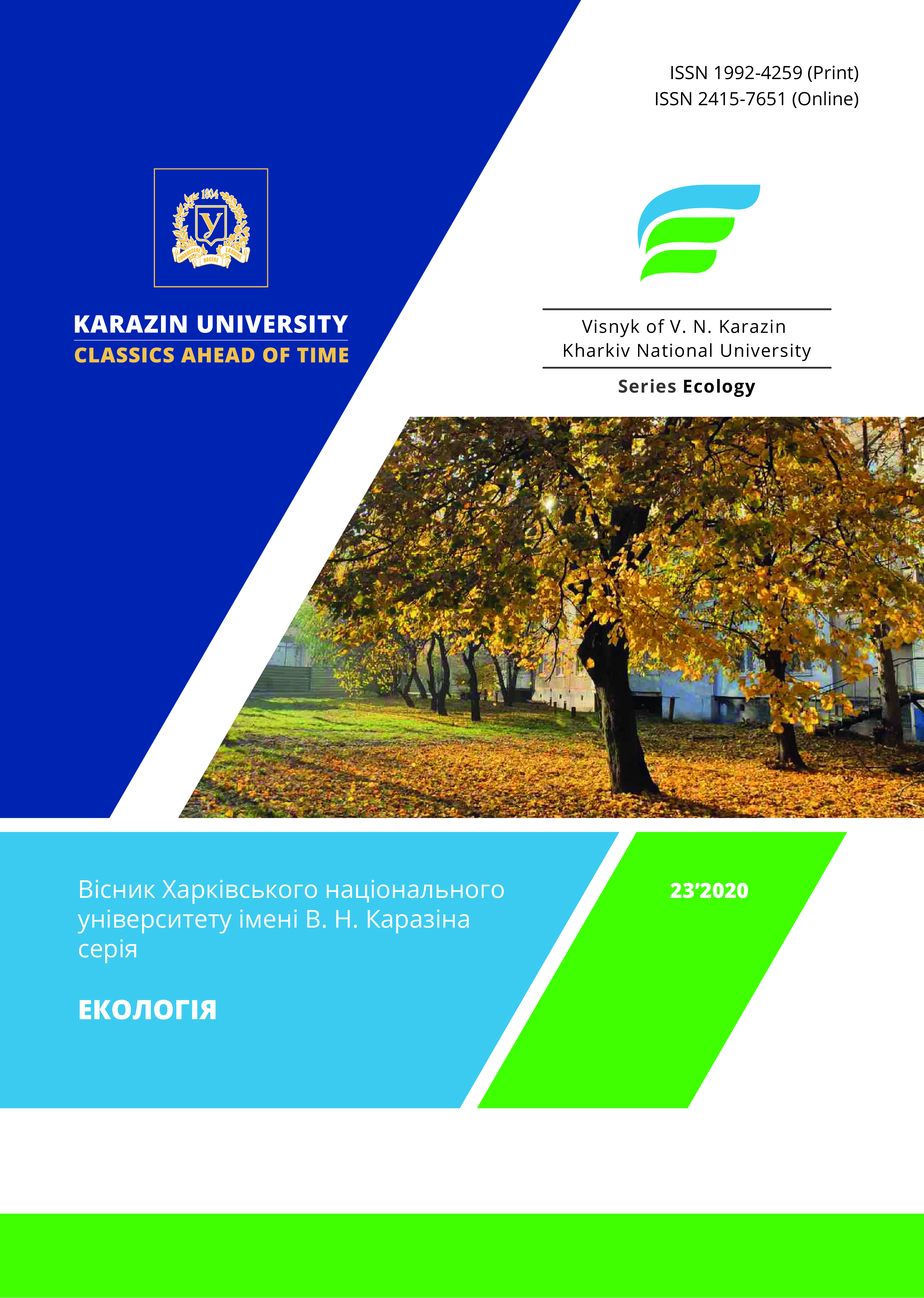Рекомендації щодо забезпечення екологічної безпеки при відновленні екосистем після пожежі
Анотація
Мета. Пошук способів покращення властивостей ґрунту лісових екосистем після дії пірогенного чинника: запропонувати технологічні заходи з відновлення якостей та покращення властивостей ґрунту екосистеми, довести ефективність використання глини в очищенні ґрунту в якості сорбенту.
Методи. Запропоновано внесення глини, як потенційного сорбенту для очищення природних ґрунтів від важких металів (ВМ). Мінеральний склад якої визначено за допомогою рентгенофазового аналізу. Також використовувався метод фіторемедіації за допомогою кульбаби звичайної для концентрування ВМ. Концентрацію іонів ВМ визначали атомно-адсорбційним методом.
Результати. Завданням експериментального дослідження стало обґрунтування застосування дешевої природної глинистої сировини без попередньої її активації для вилучення ВМ з ґрунтового розчину. Для проведення експерименту вибрана глина Харківського регіону. Доведено ефективність як використання глини в очищенні ґрунту в якості сорбенту, так і фіторемедіації кульбаби звичайної по відношенню до важких металів. Запропоновані технологічні заходи з відновлення якостей та покращення властивостей ґрунту екосистеми: виконання проектно-вишукувальних робіт, включаючи польові дослідження; виконання державного екологічного дослідження (моніторингу); очищення постраждалої ділянки від пошкоджених дерев; рекультивацію родючості ґрунтів відновлюваних територій, що передбачені проектуванням відновлення, в залежності від характерних особливостей ушкоджень ділянок і подальшого застосування відновлювальних територій.
Висновки. При постпірогенній релаксії екосистем, в умовах техногенного навантаження, доведено ефективність використання глини як сорбента в очищенні ґрунту та фіторемедіації за допомогою кульбаби звичайної по відношенню до важких металів.
Завантаження
Посилання
https://www.dissercat.com/content/vliyanie-antropogennykh-i-prirodnykh-faktorov-na-vozniknovenie-pozharov-v-lesakh-i-naselenny/read (in Russian).
Vacchiano, G., Foderi, C., Berretti R., Marchi, E. & Motta, R. (2018). Modeling anthropogenic and natural fire ignitions in an inner-Alpine valley. Natural Hazards and Earth System Sciences, 18(3), 935-948. https://doi.org/10.5194/nhess-18-935-2018
Buts, Y. (2018). Systematization of processes of pyrogenic relaxation of ecogeosystems in conditions of technogenic loading. Ecological safety, 1(25), 7-12. https://doi.org/10.30929/2073-5057.2018.1.7-12 (in Ukraine).
Krainiuk, O.V. & Buts, Yu.V. (2018). Migration ability of plumbum in soils of Kharkiv region under the influence of pyrogenic factor. Proceedings of the Ukrainian Scientific Conference: Third Sumy Scientific Geographical Readings, Sumy, 2018, October 10-12, (pp.128-131). Sumy: Sumy State Pedagogical Univer-sity named after A.S. Makarenko. (in Ukraine).
Krainiuk, O.V., Buts, Yu.V. & Nekos, A.N. (2019). Natural fire in the Rivne Reserve and its analysis. Proceedings of the International Scientific and Practical Conference: VinSmartEco, Vinnitsa, 2019, May 16-18, (pp. 25-26). Vinnitsa. (in Ukraine).
Buts, Y., Asotskyi, V., Kraynyuk, O. & Ponomarenko, R. (2019). Dynamics of migration capacity of some trace metals in soils in the Kharkiv region under the pyrogenic factor. Journ. Geol. Geograph. Geoecology, 28(3), 409-416. https://doi.org/10.15421/111938
Butz, Yu. V. (2020). Scientific and methodological bases of relaxation of ecogeosystems at technogenic loading of pyrogenic origin. (Master’s thesis). Sumy: Sumy State University. Retrieved from http://essuir.sumdu.edu.ua/handle/123456789/76266 (in Ukraine).
Neshovorova, N.P., Saveliev, V.G. & Yvantsova G.V. (2014). Investigation of the problem of forest fires as a factor of ecological danger: the regional aspect. Fundamental Research, 12 (6). 1207-1211. Re-trieved from http://www.fundamental-research.ru/ru/article/view?id=36302 (in Russian).
Gordon, J.S., Willis, J.L. & Grala, R.K. (2020). Public and forest landowner attitudes towards longleaf pine ecosystem restoration using prescribed fire. Canadian Journal of Forest Research, 50(9), 917-924. https://doi.org/10.1139/cjfr-2019-0415
Barnett, J.P. (1999). Longleaf pine ecosystem restoration: the role of fire. Journal of Sustainable Forestry, 9(1-2), 89-96. Retrieved from https://www.srs.fs.usda.gov/pubs/ja/ja_barnett007.pdf
Tartarino, P., Greco, R. & Silva, J. S. (2020.) Overstory Effects on the Understory of Aleppo Pine Plantations–Implications for Ecosystem Restoration. Forests, 11(6), 664. https://doi.org/10.3390/f11060664
Remm, L., Lõhmus, A., Leibak, E., Kohv, M., Salm, J.-O., Lõhmus, P., Rosenvald, R., Runnel, K., Vellak, K. & Rannap R. (2019). Restoration dilemmas between future ecosystem and current species values: The concept and a practical approach in Estonian mires. Journal of environmental management, 250, 109439. https://doi.org/10.1016/j.jenvman.2019.109439
Selles, O.A. & Rissman, A.R. (2020). Content analysis of resilience in forest fire science and management. Land Use Policy, (94), 104483. https://doi.org/10.1016/j.landusepol.2020.104483
Wang, L. & Fu, Q. (2020). Soil quality assessment of vegetation restoration after a large forest fire in Daxing’anling, northeast China. Canadian Journal of Soil Science, 100(2), 162-174. https://doi.org/10.1139/cjss-2019-0013
Asotskyi, V., Buts, Y., Kraynyuk, O. & Ponomarenko, R. (2018). Post-pyrogenic changes in the properties of grey forest podzolic soils of ecogeosystems of pine forests under conditions of anthropogenic loading. Journ. Geol. Geograph. Geoecology, 27(2), 175-183. https://doi.org/10.15421//111843
Buts, Y., Asotskyi, V., Kraynyuk, O. & Ponomarenko, R. (2018). Influence of technogenic loading of pyrogenic origin on the geochemical migration of heavy metals. Journ. Geol. Geograph. Geoecology, 27(1), 43-50. https://doi.org/10.15421/111829
Mikhailov, V.A. (2008). Non-metallic minerals of Ukraine. 2nd edition. Kyiv: Publishing and Printing Center «Kyiv University». (in Ukraine).
Автори, які публікуються у цьому журналі, погоджуються з наступними умовами:
- Автори залишають за собою право на авторство своєї роботи та передають журналу право першої публікації цієї роботи на умовах ліцензії Creative Commons Attribution License 4.0 International (CC BY 4.0), котра дозволяє іншим особам вільно розповсюджувати опубліковану роботу з обов'язковим посиланням на авторів оригінальної роботи та першу публікацію роботи у цьому журналі.
- Автори мають право укладати самостійні додаткові угоди щодо неексклюзивного розповсюдження роботи у тому вигляді, в якому вона була опублікована цим журналом (наприклад, розміщувати роботу в електронному сховищі установи або публікувати у складі монографії), за умови збереження посилання на першу публікацію роботи у цьому журналі.
- Політика журналу дозволяє і заохочує розміщення авторами в мережі Інтернет (наприклад, у сховищах установ або на особистих веб-сайтах) рукопису роботи, як до подання цього рукопису до редакції, так і під час його редакційного опрацювання, оскільки це сприяє виникненню продуктивної наукової дискусії та позитивно позначається на оперативності та динаміці цитування опублікованої роботи (див. The Effect of Open Access).





